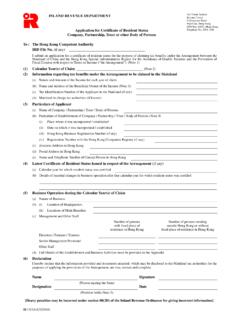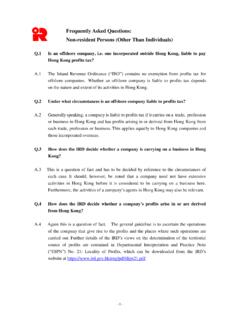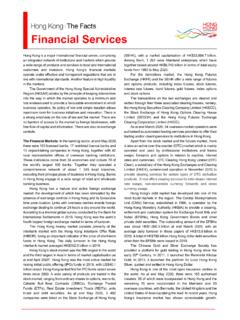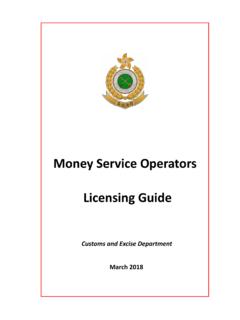Transcription of Guidelines to Acount for and Report on Greenhouse Gas ...
1 Guidelines to Account for and Report on Guidelines GreenhousetoGas Account for and Emissions andReport on Removals for Buildings Greenhouse Emissions andResidential Gas (Commercial, Removals orInstitutional for Buildings (Commercial, hong kong Purposes) inResidential or Institutional Purposes) in hong kong 2010 Edition 1. Published by the Environmental Protection Department and the Electrical and Mechanical Services Department Information referenced from World Resources Institute and World Business Council for Sustainable Development (WRI / WBCSD) is the copyright of WRI / WBCSD and must not be reproduced in any medium without licence. Information referenced from International Standard on Greenhouse Gases- Part 1: Specification with guidance at the organization level for quantification and reporting of Greenhouse gas emissions and removals, (ISO 14064-1) is the copyright of International Standard Organization (ISO) and must not be reproduced in any medium without licence.
2 First published, July 2008. Revised, February 2010. 2. TABLE OF CONTENTS. I II PRINCIPLES AND III PHYSICAL BOUNDARIES ..6. IV OPERATIONAL BOUNDARIES ..7. V QUANTIFICATION VI REPORTING EMISSIONS AND REMOVALS ..10. VII CONTACT FOR ENQUIRY ..12. VIII INFORMATION SOURCES AND REFERENCES ..12. ANNEX A SIMPLIFIED QUANTIFICATION APPROACHES AND WORKING. PROCEDURES ..13. (i) GHG Emissions from Stationary Combustion 13. (ii) GHG Emissions from Mobile Combustion 16. (iii) HFC and PFC Emissions for Refrigeration / Air-conditioning .. 18. (iv) GHG Removals from Newly Planted 20. (v) Energy Indirect GHG Emissions due to Electricity and Towngas (vi) GHG Emissions from Paper Waste Disposed at Landfills .. 24. (vii) GHG Emissions due to Electricity Used for Processing Fresh Water and Sewage by Government Departments.
3 26. (viii) Emissions / Removals not Covered in Previous 26. ANNEX B SAMPLE REPORTING ANNEX C CARBON REDUCTION LIST OF TABLES. Table 1: GHG Emissions from Stationary 27. Table 2: GHG Emissions from the Mobile Sources .. 29. Table 3: HFC and PFC Emissions from Refrigeration / Air-conditioning Equipment (Operation Process).. 32. Table 4: Direct GHG Removals from Newly Planted Trees .. 35. Table 5: GHG Emissions from Electricity Purchased from Power Companies .. 36. Table 6: GHG Emissions from Towngas Purchased from the hong kong and China Gas Company (Towngas).. 37. Table 7: Methane Generation at Landfill in hong kong due to Disposal of Paper 38. Table 8: GHG Emissions due to Electricity Used for Fresh Water Processing by Water Supplies 38.
4 Table 9: GHG Emissions due to Electricity Used for Sewage Processing by Drainage Services 39. 3. Guidelines to Account for and Report on Greenhouse Gas Emissions and Removals for Buildings (Commercial, Residential or Institutional Purposes) in hong kong I Introduction Climate change has become a challenge to the international community. The Government of the hong kong Special Administrative Region is committed to working closely with the international community in formulating measures to reduce Greenhouse gas (GHG). emissions. As a member economy of the Asia-Pacific Economic Co-operation (APEC), hong kong is working towards achieving a reduction in energy intensity of at least 25% by 2030 (with 2005 as the base year) as set out in the APEC Leaders' Declaration on Climate Change, Energy Security and Clean Development issued in September 2007.
5 Delivery of this goal can only be achieved through co-operation among the Government, the business sector and the public in general. Being a service economy without any major energy-intensive industries, electricity generation is the major source of GHG emissions in hong kong , accounting for over 60% of the total local emissions. The transport sector is the second largest GHG emission source (16%), followed by waste (12%). Among various end uses of electricity, buildings account for some 89% in hong kong . Therefore, reducing electricity consumption for building operations is instrumental in bringing down our GHG emissions. It will also have the co-benefits of reducing operational costs and improving the local and regional air quality.
6 In order to assist the users and managers of buildings to improve their awareness of GHG. emissions, measure their GHG emission performance and actively participate in actions to combat climate change; the Government has prepared this set of Guidelines (the Guidelines ). to provide a systematic and scientific approach to account for and Report on the GHG. emissions and removals from buildings in hong kong . The Guidelines are applicable to buildings which are entirely used for commercial or residential purposes. They are also applicable to most of the buildings used for institutional purposes, which include schools, universities, community centres, sports complexes, etc. They may, however, not be applicable to buildings for industrial or other special purposes because of the complexities of GHG emitting processes in these buildings.
7 With the help of the Guidelines , the users and managers of buildings can measure their GHG. performance, identify areas of improvement and conduct voluntary programmes to reduce 4. and / or offset emissions arising from buildings according to the organizational or business goals. II Principles and Applicability Accounting for and reporting on GHG emissions and removals from activities are similar to the financial accounting and reporting exercises that many business entities are familiar with. The users and / or managers of buildings (the reporting entity) should apply the Guidelines based on the following principles to ensure the GHG emissions and removals reported are true and fair representation of the GHG performance of the concerned buildings.
8 Relevance The reporting entity should ensure that the boundaries, information, data, assumptions and methodologies selected for compiling the GHG inventory can appropriately reflect the GHG. emission status of the buildings concerned and serve the needs of the internal and external users. Completeness The reporting entity should account for and Report all GHG emissions and removals within the chosen physical and operational boundaries. Specific exclusions should be disclosed and justified. Consistency The reporting entity should use consistent methodologies to allow meaningful comparisons in the GHG-related information including the trends of emissions over time. Any changes to the boundaries, information, data, assumptions and methodologies over time should be clearly reported.
9 Accuracy The reporting entity should ensure that any bias and uncertainties in quantifying GHG. emissions and removals are minimized as far as practicable. Transparency The reporting entity should disclose sufficient and appropriate information, including assumptions and references, to allow the users of the Report to arrive at conclusions /. decisions with reasonable confidence. The Guidelines are intended primarily to be applied to buildings in hong kong which are 5. entirely used for commercial (including offices, retails, restaurants, hostels and hotels) and /. or residential purposes. The Guidelines can also be applied to buildings used for institutional purposes such as schools / universities, community centres, sports complexes, etc.
10 However, care should be taken when the Guidelines are applied to buildings which have GHG emitting activities not commonly found in normal office or residential environment. The simplified quantification methodologies and conversion factors in the Guidelines are not intended to be used for activities associated with industrial buildings and / or buildings for special purposes because of the complexities of GHG emitting processes in these buildings. While there are a certain number of gases found to have effects on our climate systems, the Guidelines only cover the six types of GHG, viz carbon dioxide (CO2), methane (CH4), nitrous oxide (N2O), hydrofluorocarbons (HFCs), perfluorocarbons (PFCs) and sulphur hexafluoride (SF6), included in the Kyoto Protocol to the United Nations Framework Convention on Climate Change.







